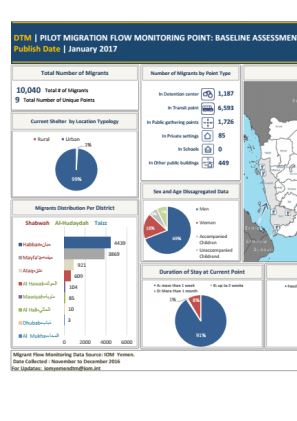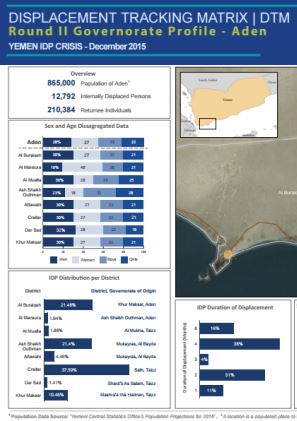-
Countries
-
Data and Analysis
-
Special Focus
-
Crisis Responses
Yemen
Desplazados internos rastreados
Movimientos de desplazamiento
4,516,000
IDMC 2023
Ronda de recopilación de datos
Sobre Yemen
Overview
The situation in Yemen has steadily deteriorated as a result of instability and increased fighting between multiple groups. Large scale internal displacement has been observed across the country since the conflict started in 2015. IOM Yemen’s DTM was launched the same year in an effort to better inform the humanitarian community about the location and needs of displaced populations. The DTM identifies both IDP and returnee locations and tracks displacement trends on a daily basis. The DTM also monitors key migrant arrivals and the return of Yemeni migrants mainly in locations across Yemen’s southern coastal border and northern border with the Kingdom of Saudi Arabia (KSA).
Rapid Displacement Tracking (RDT)
As part of the DTM’s mobility tracking, Rapid Displacement Tracking (RDT) primarily tracks IDP and returnee populations throughout Yemen. Information on areas of displacement and return, origins and reasons for displacement, shelter types, and priority needs are collected on a daily basis. RDT data is not representative of all displacements occurring in Yemen due to access constraints in many governorates.
Area Assessment (AA)
The Area Assessment collects stock figures on the number of IDPs, returnees, and migrants, as well as the origins, reasons for displacement, shelter types, and the situation overview at a target location. The Area Assessment data is collected through an extensive key informant network at the smallest geographical area that is operationally possible. This assessment is used to verify and update the baseline information in quarterly cycles, with field staff revisiting and updating information on all previously identified locations populated by IDP and returnee populations.
Flow Monitoring Registry (FMR)
The DTM’s Flow Monitoring Registry (FMR) monitors key third-country migrant arrivals and departures mainly in locations across Yemen’s southern coastal border as well as key Yemeni returns on the northern border with the KSA. Enumerators placed at Flow Monitoring Points (FMPs) record arrivals of migrants and returning Yemeni nationals in order to identify different patterns and types of migration, and to provide quantitative estimates to help define the population of irregular migrants entering the country. FMR is not representative of all flows in Yemen and should be understood only as indicative of the individuals recorded at FMPs during the timeframe indicated. Access constraints limit the ability to collect data at some migrant arrival points.
Multi-Cluster Location Assessment (MCLA)
In order to carry out an evidenced-based needs analysis for the Humanitarian Needs Overview (HNO), and to allow humanitarian partners to make planning decisions, the Yemen Inter-Cluster Coordination Mechanism (ICCM) proposed to carry out a Multi-Cluster Location Assessment (MCLA). This also involves the Technical Working Group (TWG) to formulate planning and implementation processes, as well as data examination and compilation. This assessment is based on the MCLA tool that has been used to assess IDP needs in previous years but has been broadened to include all key population groups that are in need of humanitarian assistance according to the previous HNO. The MCLA will provide nationwide data and evidence-based findings for the HNO to better inform the Humanitarian Response Plan (HRP) in Yemen.
Contacto
Current Donors
- Canada
- ECHO
- GFFO
- BHA
Para obtener resultados de búsqueda más avanzados, vaya a la Página de búsqueda avanzada de informes
Yemen — Weekly Situation Report (22—28 April 2018)
IOM is the co-lead of the Task Force on Population Movements (TFPM) and is responsible for tracking IDP and returnee movements across Yemen.
Yemen — Flow Monitoring Report 4 (July 2017)
Flow Monitoring is an exercise through which DTM monitors trends of mobility into, out of, and within Yemen, in order to monitor the human mobility of other country nationals and better inform the humanitarian community and those responding.
Oct 28 2017
Yemen — Flow Monitoring Report 4 (July 2017)
Yemen — TFPM Report 16 (October 2017)
As of 01 September 2017, the TFPM has identified, 2,014,026 internally displaced persons (IDPs) (335,671 households) who have been displaced due to conflict since March 2015, dispersed across 21 governorates.
Oct 22 2017
Yemen — TFPM Report 16 (October 2017)
Yemen — TFPM Report 15 (June 2017)
As of 01 June 2017, the TFPM has identified, 1,980,510 internally displaced persons (IDPs) (330,085 households) who have been displaced due to conflict since March 2015, dispersed across 21 governorates.
Jul 19 2017
Yemen — TFPM Report 15 (June 2017)
Yemen — Flow Monitoring Report 3 (May — June 2017)
FM is an exercise through which DTM monitors trends in mobility into, out of, and within a country or region.
Yemen — Governorate Profiles Round 18 (April 2017)
The document contains 11 dashboards of 11 governorates. The dashboards contain information on total governorate population, IDP and returnee numbers, demographic data, duration of displacement and needs.
Yemen — TFPM Report 14 (May 2017)
As of 01 April 2017, the TFPM has identified, 1,988,946 internally displaced persons (IDPs) (331,491 households) who have been displaced due to conflict since March 2015, dispersed across 21 governorates.
May 01 2017
Yemen — TFPM Report 14 (May 2017)
Yemen — Governorate Profiles Round 16 (February 2017)
The document contains 11 dashboards of 11 governorates. The dashboards contain information on total governorate population, IDP and returnee numbers, demographic data, duration of displacement and needs.
Yemen — TFPM Report 13 (February 2017)
As of 01 February 2017, the TFPM has identified, 1,991 ,340 internally displaced persons (IDPs) (331,890 households) who have been displaced due to conflict since March 2015, dispersed across 21 governorates.
Mar 14 2017
Yemen — TFPM Report 13 (February 2017)
Yemen — TFPM Sana'a Governorate Monitoring Sheet 16 (February 2017)
The Governorate Monitoring Sheets are a side-product of the ongoing work and internal procedures conducted by IOM DTM and can be used to examine the changes in population movement. The figures represented will not be officially endorsed by the Yemen HCT.
Mar 14 2017
Yemen — TFPM Sana'a Governorate Monitoring Sh…
Yemen — Governate Profiles Round 13 (February 2017)
The document contains 21 dashboards of 21 governorates (report 13). The dashboards contain information on total governorate population, IDP and returnee numbers, demographic data, duration of displacement and needs.
Yemen — TFPM Report Dashboard 13 (1 February 2017)
From December 2016 to January 2017 the TFPM observed an overall decrease in the conflict-related displacement of 15,876 individuals (-0.79%). On the other hand, there has been an overall increase in the conflict-affected return population of 21,222 individuals (+2%).
Yemen – TFPM Multi-Cluster Needs Assessment of IDPs, Returnees and Host Communities (February 2017)
From August to September 2016, the Taskforce on Population Movement (TFPM) implemented a multi-cluster location assessment to gather more in-depth data on the IDP, returnee and host populations, in 3,292 locations hosting IDPs and/or returnees, covering all 22 governorates in Yemen.
Yemen — TFPM Report 12 (January 2017)
The 12th TFPM identifies, in connection with the ongoing conflict, 2,007,216 internally displaced persons (IDPs) across 21 governorates; the majority, 50%, are displaced in Hajjah, Taizz, Amanat Al Asimah and Sana’a.
Feb 06 2017
Yemen — TFPM Report 12 (January 2017)
Yemen — Flow Monitoring Dashboard (January 2017)
10,040 migrants were identified at 9 Flow Monitoring Points (FMPs). 69% of migrants were men, 18% were women, and 13% were children (including 6% of unacommpanied children). 77% of identified migrants were from Ethiopia, 22% from Somalia.
Feb 02 2017
Yemen — Flow Monitoring Dashboard (January 2017)
Yemen — TFPM Report 11 (October 2016)
Conflict related: The 11th TFPM identified, in connection with the ongoing conflict, 2,179,278 internally displaced persons (IDPs) who remain in a situation of displacement across 21 governorates; the majority, 51%, are displaced in Hajjah, Taizz, and Sana’a.
Dec 03 2016
Yemen — TFPM Report 11 (October 2016)
Yemen — Governorate Profiles Round 10 (August 2016)
The document contains 21 dashboards of 21 governorates. The dashboards contain information on total governorate population, IDP and returnee numbers, demographic data, duration of displacement and needs.
Yemen — TFPM Report 10 (July 2016)
The 10th TFPM affirms a population of concern, in connection with the ongoing conflict, of 3,154,572 individuals.
Aug 04 2016
Yemen — TFPM Report 10 (July 2016)
Yemen — TFPM Report 9 (May 2016)
In connection with the ongoing conflict, the 9th report affirms a population of concern of 2,818,072 individuals.
Jun 01 2016
Yemen — TFPM Report 9 (May 2016)
Yemen — (Taizz) Governorate Profile Round IV (March 2016)
The report identified Taizz governorate to host the highest proportion of the IDP population with 620,934 individuals across 282 locations.
Yemen — TFPM Report 8 Dashboard (1 April 2016)
As of 1 April 2016, the TFPM Report Dashboard identified 2,755,916 displaced individuals (452,449 displaced households) in Yemen. 26% of the displaced individuals are men and 29% are women.
Apr 05 2016
Yemen — TFPM Report 8 Dashboard (1 April 2016)
Yemen — TFPM Report 7 (February 2016)
The 7th TFPM Report for Yemen has identified 2,430,178 displaced individuals compared compared to 2,509,062 individuals in the 6th report (a decrease of 78,884 individuals).
Mar 01 2016
Yemen — TFPM Report 7 (February 2016)
Yemen — (Ibb) Governorate Profile Round II (January 2016)
In Ibb, with a population of 2,719,000 people, 104,316 Internally Displaced Persons (IDPs) and 3,108 returnees were registered. Dissagregated by sex and age, the following data was registered in relation to the IDPs: 23% men, 25% women, 27% girls, 25% boys.
Yemen — (Aden) Governorate Profile Round II (December 2015)
On the 10th December the TFPM had identified approximately 2.5 million people to have fled their homes in the whole of Yemen and observed a decrease in the overall displaced population in the south with a shift in focus to the northern governorates since 15th October, 2015.
Pagination
Para obtener resultados de búsqueda más avanzados, vaya a la Página de búsqueda avanzada de conjuntos de datos
Pagination
- First page
- Previous page
- …
- 8
- 9
- 10
- 11
- 12
- 13
- 14
- 15
- 16


























